Measuring Social Share of Voice Through AI Analytics
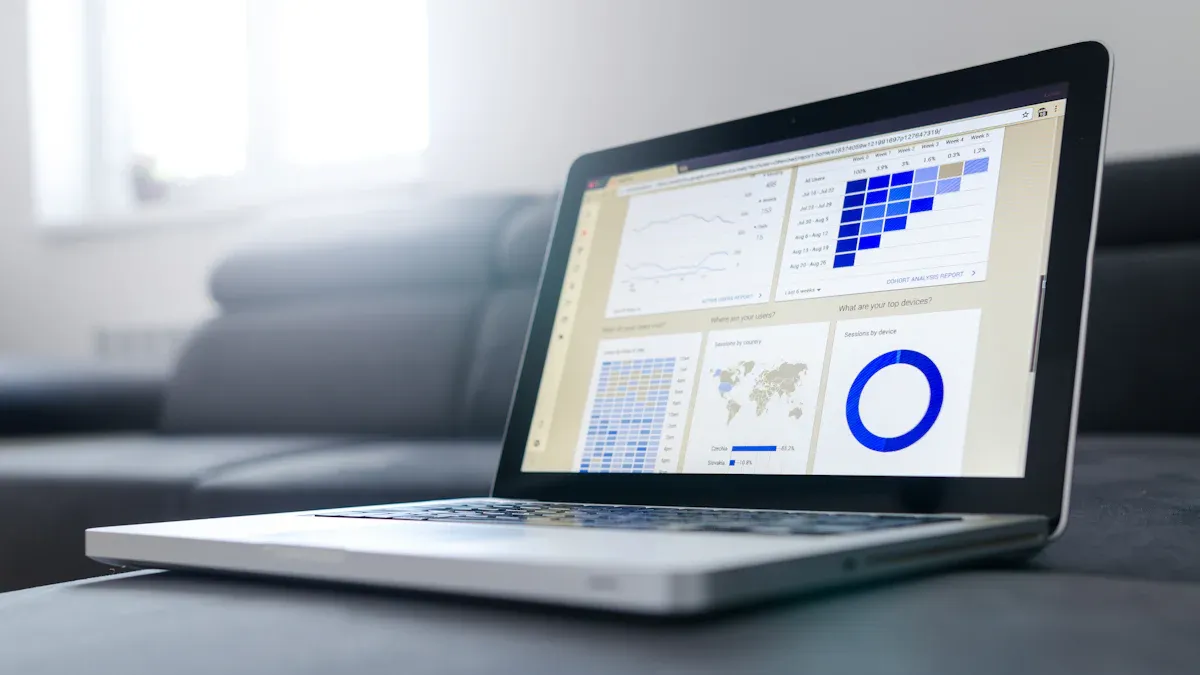
AI analytics changes how brands check Social Share of Voice. It gives fast and exact insights. Top platforms, like Brandwatch and Mention, look at millions of posts each day. They watch many sources in real time, as shown below:
AI Tool / Feature | Statistical Data / Capability | Impact on SOV Measurement |
|---|---|---|
Brandwatch | Looks at millions of posts every day | Lets brands study lots of data right away |
Mention | Used by 4,000 companies watching 1 billion sources | Watches many sources at once in real time |
Sprout Social | Gives detailed SOV reports on many platforms | Shares quick insights and deep engagement info |
AI Sentiment Analysis | Knows how people feel, not just how often they talk | Makes results better by using feelings in data |
Context Understanding | Gets the small details in talks | Makes SOV data more useful and clear |
Predictive Analytics | Tells what topics may trend soon | Helps brands change plans before trends start |
Cross-Platform Tracking | Checks SOV on social media, blogs, forums, and news sites | Gives a full and quick way to measure |
Real-Time Optimization | Changes SOV plans right away using AI feedback | Makes answers faster and more correct |
It is now very important to know your brand’s place and how you compare to others. AI branding research has grown a lot, as you can see in the chart below:
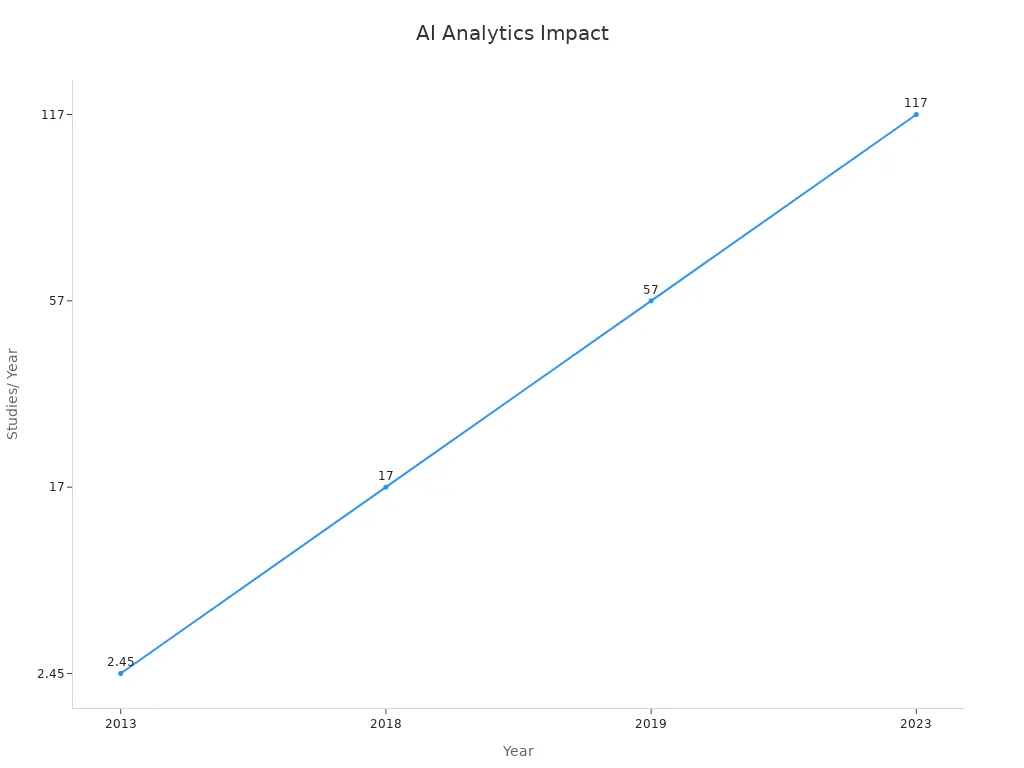
Top companies now use more than old ways. They get a full view with AI-powered analytics.
Key Takeaways
AI analytics lets brands measure Social Share of Voice quickly and more exactly. It tracks millions of online mentions on many channels at the same time. Using AI tools gives brands clear ideas about how people feel about them. This helps brands change marketing plans fast and connect better with customers. Social Share of Voice shows how much people talk about a brand compared to others. This helps brands know their place in the market and grow their influence. Top AI platforms have features like sentiment analysis, predictive trends, and multi-channel tracking. These features save time and help brands make better choices. Brands can raise their Social Share of Voice by making fun content and working with influencers. They can also watch competitors and use AI to guess what customers want.
AI Analytics Benefits
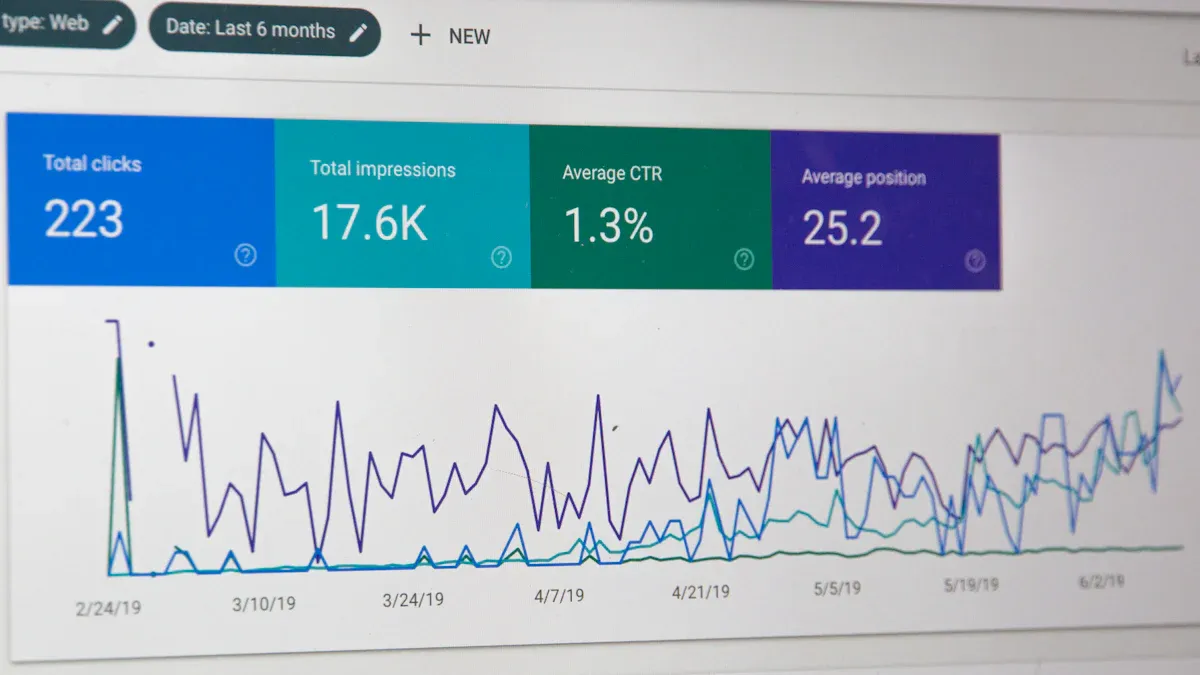
Speed and Precision
AI analytics works very fast and is very accurate. Machine learning finds brand mentions that people might miss. Automated tools save time because they collect data for you. Brands can watch mentions on many channels at the same time. This makes sure every important talk is counted. AI gives real-time reports, so marketers can change plans quickly. The table below shows how AI analytics helps digital engagement:
Metric Description | Improvement with AI Analytics | Source/Context |
|---|---|---|
Increase in click-through rates | 131% | Blueshift, 2021 |
Increase in overall engagement | 41% | Blueshift, 2021 |
Higher email open rates (optimal send times) | 184% | Blueshift, 2021 |
Increase in social media engagement | 83% | Blueshift, 2021 |
Longer average session duration on AI-personalized sites | 59% | Blueshift, 2021 |
Increase in session time using Sephora’s AI tool | 45% | Retail Dive, 2022 |
Increase in customer retention rates with AI | 25% | Accenture, 2022 |
Higher customer lifetime value with personalized content | 28% | Salesforce, 2021 |
AI analytics puts together data from paid, earned, and owned media. This helps brands see their whole digital presence.
Real-Time Insights
Real-time insights let marketers make quick choices using data. AI checks things like conversion rates and engagement rates as they happen. Marketers can use A/B testing to make campaigns better right away. Email and social media stats show trends and help improve engagement. Paid ad data, like cost per acquisition, helps use money better. The chart below shows how much AI improves digital engagement:
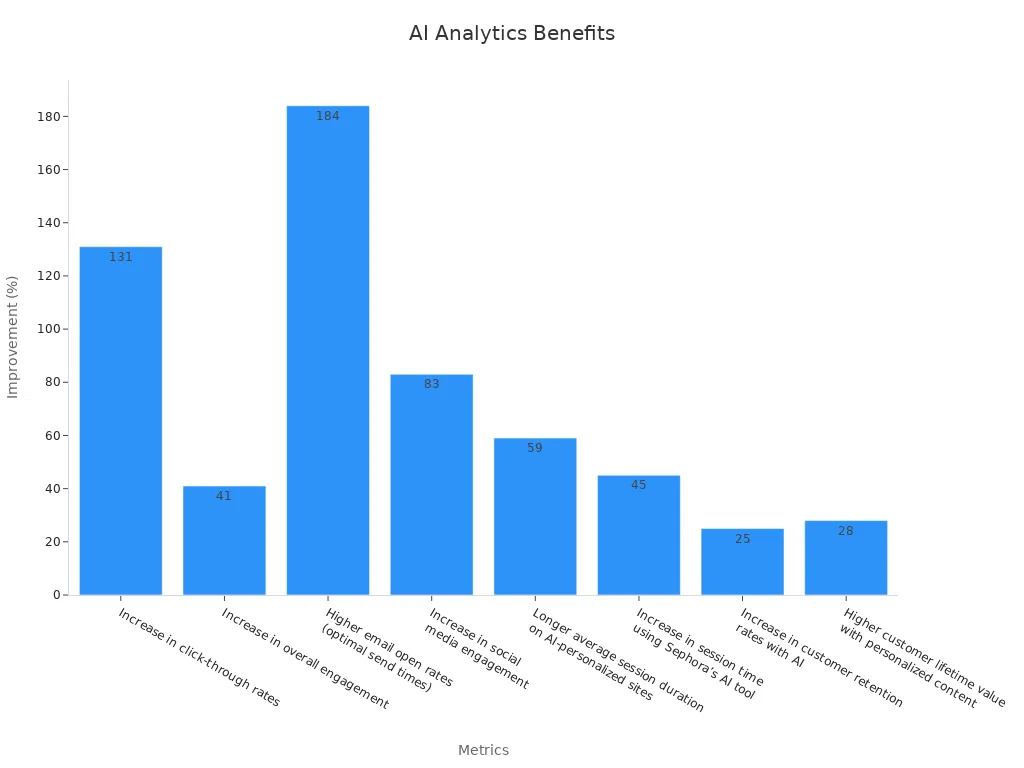
Real-time data helps brands keep getting better and get more engagement.
Sentiment Analysis
AI-powered sentiment analysis does more than count mentions. It learns how people feel about a brand. This tech checks if talks are positive, negative, or neutral. Brands can see changes in public opinion fast. AI also watches engagement, keyword use, and what competitors do. These insights help brands answer feedback and make their messages better. Using sentiment analysis helps companies protect their reputation and connect with their audience.
Social Share of Voice: Definition
What SOV Measures
Social Share of Voice shows how much people talk about a brand compared to others. Brands count mentions on social media, news, and search engines. They check things like:
Impressions and branded hashtag use
Organic website visits
Search engine results page (SERP) views and clicks
Organic keyword rankings
Backlinks from other sites
Paid ad numbers like views and ad spots
Brands use social listening tools to get this data. They also look at what their competitors are doing. Marketers watch trends over time to see if their campaigns work and if more people know the brand. They often add engagement rates and paid ad KPIs, like Cost per Acquisition and Return on Ad Spend, to connect visibility with business results.
Evolution of SOV
The idea of Social Share of Voice has changed over the years. Peckham’s early research showed a link between marketing spend and market share. John Philip Jones found big brands could keep their market share with less SOV. Smaller brands needed more SOV to grow. Peter Field and Les Binet talked about "excess share of voice." This means brands with more SOV than their market share often grow faster. Lidl grew its market share by doubling its SOV. Today, measuring SOV is harder because there are many digital channels and new data sources. Some experts now use "share of search" to guess brand growth.
Why SOV Matters
Social Share of Voice helps brands see where they stand in the market. A high SOV often leads to more sales and stronger brand awareness. Marketers use SOV to compare with competitors and change their plans. Watching SOV over time shows if a brand’s influence is going up or down. Studies show that higher digital SOV links to better market share and business growth. Brands that track SOV can find market gaps, react to competitors, and do better.
SOV Calculation Methods
Metrics and Formulas
Marketers use simple math to measure Social Share of Voice. They compare how many times a brand is mentioned to all mentions in the market. This works for social media, paid ads, or website visits. The formula is:
Social Share of Voice (%) = (Your Brand’s Mentions ÷ Total Market Mentions) × 100
First, brands count their own mentions and their competitors’ mentions. They add up all the mentions to get the total. Next, they divide their brand’s number by the total and multiply by 100. This gives them a percentage.
For example, if a brand gets 500 mentions and the total is 1,500, the math is (500 ÷ 1,500) × 100 = 33.33%.
Metric | Value |
|---|---|
Your Brand’s Mentions | 500 |
Competitor 1 Mentions | 300 |
Competitor 2 Mentions | 450 |
Competitor 3 Mentions | 250 |
Total Market Mentions | 1500 |
Social Share of Voice (SOV) | 33.33% |
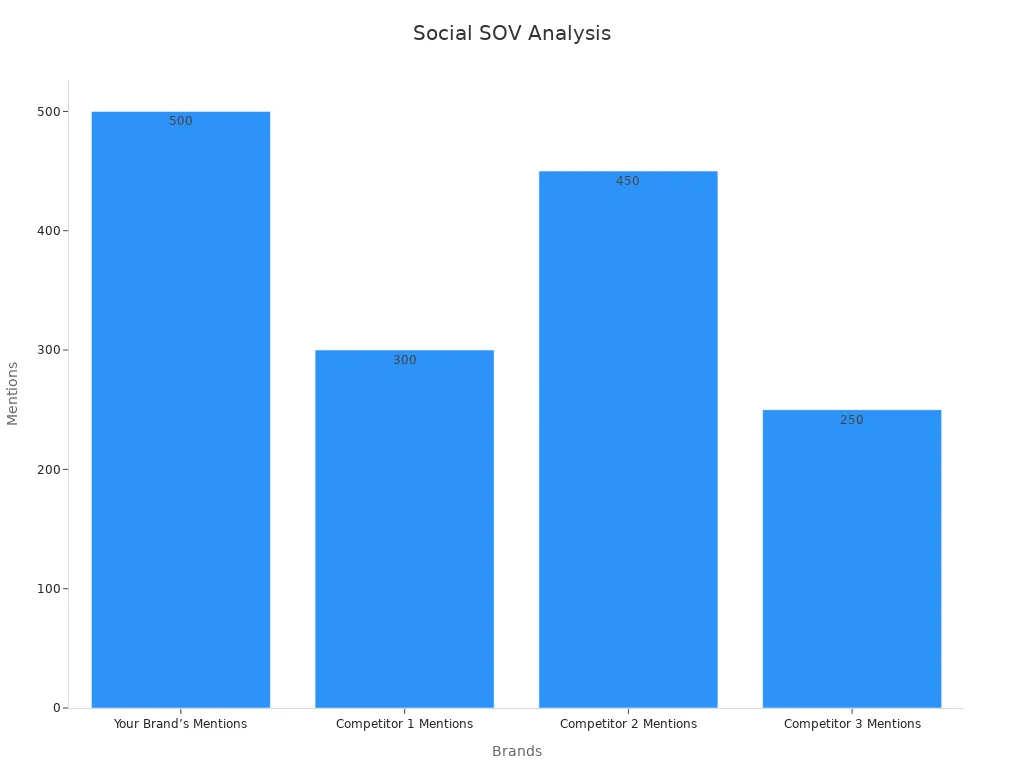
Brands can also look at likes or shares to see their share of engagement.
Multi-Channel Data
Brands get a better idea of their place by using data from many channels. This means they collect info from social media, paid ads, influencer posts, and regular media. When they put these together, they see the whole picture of their brand and how people react.
Multi-channel data helps brands see their reach on different sites.
This way, they can decide where to spend their marketing money.
Big brands like Nike and Apple use many channels to get more trust and attention.
Using tools like Sprout Social and Brandwatch makes the data more correct and fills in missing parts.
Tracking Social Share of Voice on many channels helps brands find trends, measure awareness, and act fast when things change.
AI Tools for Social Share of Voice
Leading Platforms
Many companies use AI-powered platforms to watch their brand online. These tools help brands know what people say about them on social media, news, blogs, and forums. Some top platforms are:
Brandwatch: Gives real-time sentiment analysis, social listening, crisis alerts, and checks visual content.
Mention: Used by over 4,000 companies, it watches millions of sources live and sends instant alerts.
Quantilope: Offers AI-powered surveys, automated workflows, and predictive analytics for quick consumer insights.
YouScan: Uses image recognition and logo detection to check brand sentiment in pictures.
Crayon: Watches competitors with event-driven alerts and automated tracking.
Peak.ai: Uses predictive modeling, customer segmentation, and connects with communication platforms.
Exploding Topics: Spots early trends and tracks market signals for planning.
Outranking.io: Gives AI-driven SEO insights, keyword help, and real-time performance tracking.
Customfit.ai: Changes websites in real time and targets audiences with dynamic journeys.
Thousands of companies trust these platforms for accurate, real-time, and predictive insights into their Social Share of Voice.
Key Features
Top AI analytics tools are special because of their advanced features. These features help brands make better choices and react fast to market changes.
Description | Example Tools / Functionalities | |
|---|---|---|
Real-Time Data Processing | Handles live data so brands can act right away. | Quantilope (real-time consumer insights), dynamic pricing models |
Predictive Analytics | Uses machine learning to guess trends and customer actions. | Morning Consult, Alteryx, Quantilope |
User-Friendly Interfaces | Has dashboards and easy language queries for all team members. | Customizable dashboards |
Strong Integration Capabilities | Connects with CRM, social media, and BI platforms for a full view of brand performance. | Peak.ai (integrates with CDP, CRM, social media) |
Customization and Scalability | Fits different industries and growth stages, so brands can grow easily. | Qualtrics, scalable AI tools |
Many platforms also automate jobs like making content, scheduling, and reporting. This saves time and cuts down on mistakes. AI tools study audience insights, change content based on past results, and track likes, shares, and comments live. Brands can do more on many platforms without hiring more people.
Manual vs. AI Tools
Manual tracking means people collect and check data by hand. This takes a lot of time and can lead to mistakes or missing info. AI-powered tools fix this by automating the work and giving faster, more correct results.
AI tools like Keatext cut analysis time by up to 98%, making feedback almost instant.
Thematic makes feedback analysis 95% faster, saving time and money.
BuildBetter speeds up feedback analysis by 10 times with smart filters and live insights.
Zendesk AI automates support jobs, cutting manual work by 92% and making responses faster.
AI tools are better at finding sentiment and themes, so brands can decide faster than with manual work.
AI-powered tools do boring jobs automatically, so people spend less time on routine tasks.
Automation lowers labor costs, but manual posting needs more staff and can raise costs by 40-60%.
AI tools work on many platforms at once, but manual ways have limits and can lower engagement by up to 25%.
Manual posting lets people be creative and personal, but it takes 15-20 hours each week for every platform, so big brands have trouble keeping up.
Using both AI tools and manual posting can give the best results, mixing speed with real engagement.
More companies now use AI tools like Mention, trusted by over 4,000 companies, showing a move toward automation and smarter analytics in Social Share of Voice measurement.
Measuring SOV with AI

Setup and Framework
Brands first make a plan to measure Social Share of Voice with AI. They pick AI tools that fit their goals and industry. These tools use large language models to check millions of online talks, news, and social media posts. The 'share of model' metric uses AI to find brand mentions in big data sets. This helps marketers track brand visibility in a fast and cheap way. Companies like Jellyfish now check if these AI numbers match real market share. By using AI’s synthetic data, brands get quick and scalable insights that old surveys cannot give.
Tip: Make clear goals before starting an AI system. Choose which channels and competitors to watch for the best results.
Data Collection
AI tools collect data from many places automatically. They watch social media, blogs, forums, and news sites in real time. Brands get alerts right away when their name shows up or when feelings change. AI saves money by doing data collection instead of people. It also helps brands handle lots of info quickly and correctly.
AI lets brands watch mentions and sentiment as they happen.
Automated tools study how people act and how much they engage.
AI content tools help make more blogs and boost website visits.
Chatbots give help all day, which can raise sales and improve customer service.
AI checks campaign success by looking at engagement, reach, and conversion rates in real time.
With these tools, brands can react to Social Share of Voice changes right away.
Analysis and Reporting
After collecting data, AI platforms study and report on key metrics. These systems use smart algorithms to spot trends, check sentiment, and compare brands to rivals. Marketers get easy-to-read dashboards that show what is working and what needs work. The table below lists common metrics used in AI Social Share of Voice analysis:
Metric Name | Description | Measurement Focus / Use Case |
|---|---|---|
Share of Voice (SOV) | Percent of online talks about a brand compared to others. | Checks brand visibility and market spot by comparing to rivals. |
Presence Score | Number that mixes volume, reach, and past data into one score. | Shows how popular and strong a brand is online right now. |
Advertising Value Equivalency (AVE) | Turns earned media into a guessed money value. | Gives a real ROI view by matching earned media to paid ads. |
Volume and Reach | Counts mentions and the size of the audience who saw them. | Measures how big and wide brand talks are. |
Sentiment | Checks if mentions are positive, negative, or neutral. | Shows how people feel and react to the brand. |
Engagement | Looks at likes, comments, shares, retweets, saves, and clicks. | Shows how much people interact with brand mentions. |
Hashtag Performance | Checks how visible and engaging certain hashtags are for the brand or campaigns. | Tracks how well campaigns work and if topics matter in talks. |
Trending Topics | Finds popular themes and topics about the brand or industry. | Helps brands change messages and find new content ideas based on what is hot. |
Top Authors and Sources | Finds important people or media that make strong mentions. | Focuses on key voices that shape how people see the brand and start talks. |
AI gives fast and useful reports. Marketers use these to change campaigns, fix messages, and build a better brand image. AI can handle huge data sets right away, so measurement is more exact and quick. Brands using AI for Social Share of Voice can make smart choices faster than before and get ahead of others.
Strategies to Boost SOV
Content Optimization
Brands make their Social Share of Voice better by making content people like. They use special calls-to-action, fun quizzes, and designs that work on phones. Pictures and videos help posts get more attention. Personalized CTAs work 42% better than regular ones. Fun content can make twice as many people take action. Marketers watch things like click-through rate, time on page, and social shares to see what works best.
Metric | Description | Indicator of Improvement |
|---|---|---|
Click-Through Rate | Users clicking links or CTAs | Above 2% shows strong engagement |
Time on Page | Duration users spend on content | Longer time means higher interest |
Social Shares | Content shared on social platforms | More shares expand organic reach |
Conversion Rates | Users completing actions (sign-ups, purchases) | Higher rates show successful content |
Google Analytics and HubSpot help marketers check these numbers. They use A/B testing and split audiences to make better plans.
Influencer Engagement
Influencers help brands find new fans and build trust. Companies look for important influencers and watch their mentions with special tools. HP used big data to see how much influencers helped their Share of Influence. This showed that working with influencers can raise Social Share of Voice. Brands use numbers like engagement rate, reach, website visits, and conversions to see how well influencer partnerships work.
Metric | Description | Example |
|---|---|---|
Engagement Rate | Interaction with influencer content | Likes, comments, shares, saves |
Reach | Unique users exposed to content | Followers who saw an Instagram story |
Website Traffic | Visits from influencer content | Clicks on trackable links |
Conversions | Actions after engaging with influencer content | Purchases using discount codes |
Brand Sentiment | Tone of audience comments and mentions | Positive or negative social media comments |
Competitor Monitoring
Brands watch what their competitors do to find ways to get better. They see which sites their rivals use and how they talk to people. Watching helps brands spot problems, compare results, and get new ideas for content. Tools like Awario, Brandwatch, and Sprout Social give fast data and reports. Checking on competitors often helps brands stay ahead and change plans quickly.
Finds out who the competitors are and what sites they use.
Compares social media results with others.
Spots problems and missing chances on social media.
Gives ideas for new types of posts.
Helps pick the best times to post.
One client grew their Social Share of Voice by using social listening and checking on rivals. They focused on Instagram, LinkedIn, TikTok, and YouTube.
Predictive Marketing
Predictive marketing uses AI and old data to guess what customers will do. Brands make content and ads that fit what people want. This helps more people notice and talk about the brand. Omnichannel marketing gives the same experience on every site. AI-powered sentiment analysis lets brands know how people feel and spot trends. This helps make better content and work with the right influencers. Real-time analytics can guess what products people want and help brands change plans fast, raising Social Share of Voice.
Predictive analytics and using data help brands make content people care about. This makes the brand stronger in the market.
AI Trends in SOV
AI-Generated Content Tracking
AI-powered tools now help brands see how visible they are online. These tools do more than just check ad spending. They use live data from search engines, social media, digital ads, and earned media. AI brings together things like search ranking, backlink numbers, branded mentions, and engagement stats. This gives a fuller picture of Social Share of Voice. Natural language processing and social listening tools help brands know what people feel and say. AI makes checking data faster and more correct. Marketers can find trends, see how people feel, and react fast to changes in brand visibility.
AI watches brand mentions and engagement as they happen.
It uses sentiment analysis to show how people feel about brands.
AI helps brands make better content and learn about their audience.
Marketers use AI to build stronger link plans and study competitors.
Live reports let teams act quickly when talks change.
Dashboard Innovations
New dashboards use smart tech to give live updates. Real-time Voice of Customer dashboards use natural language processing, sentiment analysis, and predictive analytics. These dashboards show feedback from many digital places. Marketers can spot trends right away and see which messages work best. This helps teams make fast choices and react to the market. Visualization tools, like charts and heat maps, turn hard data into simple ideas. People check the data and strong rules keep it correct and safe. Tools like Keyhole bring together analytics from X, Instagram, Facebook, YouTube, LinkedIn, and TikTok. Brands can track mentions, what competitors do, and influencer actions all in one spot.
Real-time dashboards help brands connect with customers and build loyalty by giving quick insights.
Future Outlook
AI analytics will keep changing how brands measure Social Share of Voice. Predictive analytics and machine learning will give deeper insights and better guesses. Data clean rooms will let brands share data safely and protect privacy. Visual and voice analytics will help brands learn about audiences in new ways. Brands already use AI-powered sentiment analysis and live data to get more engagement and better returns.
Metric | Improvement / Projection |
|---|---|
Global Voice Recognition Market Size | |
Connection Rates Increase | Up to 25% |
Conversation Quality Boost | 30% |
Conversion Rates Increase | 20% |
Call Handling Time Reduction | 15% (McKinsey research) |
Conversion Rate Increase | 20% (McKinsey research) |
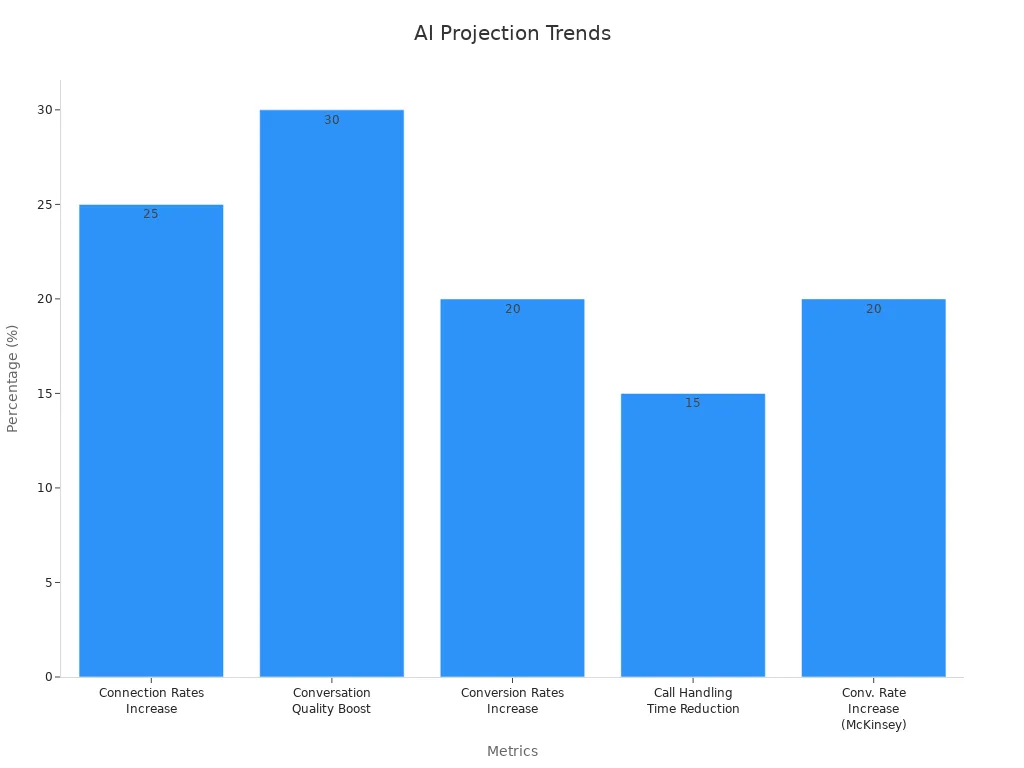
Data clean rooms will make sharing safer and protect privacy.
Visual and voice analytics will help brands reach people in new ways.
Predictive ROI analysis will help marketers plan and measure success.
AI analytics helps brands measure Social Share of Voice better. Teams can see real-time insights and act quickly. This helps them stay ahead of other brands. Companies using AI tools get better results and grow stronger. If you want to learn more, check out case studies or join webinars about AI in marketing. These can help you understand the topic even more.
FAQ
What is Social Share of Voice (SOV)?
Social Share of Voice shows how much people talk about a brand compared to others. Brands use this to see where they stand in the market. It also helps them watch how much they show up online.
How does AI improve SOV measurement?
AI tools work much faster than people. They find when a brand is mentioned and check how people feel. These tools give updates right away. This helps brands make quick choices and fix their plans.
Which channels do AI tools monitor for SOV?
AI tools watch social media, blogs, news, forums, and paid ads. Some also check influencer posts and pictures. Watching many places helps brands see the full picture of how people see them.
Can small businesses benefit from AI-powered SOV tools?
Yes. Small businesses can save time and money with AI tools. These tools collect and report data by themselves. They help small teams keep up with bigger brands by giving correct and fast updates.
See Also
Boosting Viewer Interaction Using TikTok Analytics Tools Effectively
Writesonic AI And QuickCreator Battle For Content Creation Supremacy
Which SEO Trends And Forecasts Should You Track In 2024
Mastering Content Analysis To Surpass Your Industry Rivals
How 2024 Blogging Trends Are Shaping Digital Marketing Strategies

